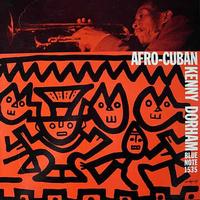K.D.'s Motion – Kenny Dorham
A slick Kenny Dorham blues. Lead sheets, second & third parts, concert condensed score and bass part available.
- Recording: Kenny Dorham - Afro-Cuban
- Recorded on: January 30, 1955
- Label: Blue Note (BLP 1535)
- Concert Key: E-flat
- Vocal Range: , to
- Style: Swing (medium)
- Trumpet - Kenny Dorham
- Tenor Sax - Hank Mobley
- Baritone Sax - Cecil Payne
- Piano - Horace Silver
- Bass - Percy Heath
- Drums - Art Blakey
0:00
0:00
Buy MP3
Video
- Description
- Historical Notes
- Solos
- Piano Corner
- Bass Corner
- Drum Corner
- Guitar Corner
- Inside & Beyond
- Minus You
Our audio excerpt starts with the intro, where the three-part harmonized horn section plays tutti figures with rhythm section before the rhythm section starts playing back beats behind the horn line. This is a slick K.D. blues melody with a super-slick laid back rhythmic figure going into the third measure of the melody. You definitely need to hear it before you try to read it, because it looks super complicated. Once you've mastered it, it sure feels great.
As with most of Dorham's compositions, we'll often give you a condensed score edition (recommended for pianists and drummers), and, as in this case, a separate Bass part which clarifies the bass player's important role of holding everything together.
After the head is played twice, there's an eight-measure Interlude section: the first soloist solos over punctuated sustained rhythm section modulations that climax in a break for the soloist. There aren't a lot of horn harmonies, but enough to call for separate second and third part editions. If you don't have the luxury of a three-horn front line, it works great in a quartet format.
As with most of Dorham's compositions, we'll often give you a condensed score edition (recommended for pianists and drummers), and, as in this case, a separate Bass part which clarifies the bass player's important role of holding everything together.
After the head is played twice, there's an eight-measure Interlude section: the first soloist solos over punctuated sustained rhythm section modulations that climax in a break for the soloist. There aren't a lot of horn harmonies, but enough to call for separate second and third part editions. If you don't have the luxury of a three-horn front line, it works great in a quartet format.
"Afro-Cuban" was recorded at Rudy Van Gelder's legendary Hackensack Studio.
This is Kenny Dorham's second album as a leader but his first as leader for Blue Note. His actual first recording for that label was in 1947 as a member of Art Blakey's Messengers, an octet. The "Jazz Messengers" everyone is more familiar with recorded under that cooperative group name in November of 1955: "The Jazz Messengers at the Cafe Bohemia" (see Prince Albert).
However, the "Afro-Cuban" session (with four out of five members of the Jazz Messengers) actually falls in between the Jazz Messengers' first recording which was under the leadership of Horace Silver (two sessions: November 13, 1954, and February 6, 1955).
The "Afro-Cuban" album was assembled from two recording sessions. K.D.'s Motion comes from the first session where the music was basically straight ahead swing. La Villa also comes from the first session; it has a small Latin section starting the bridge. The second session, two months later, was the main Afro-Cuban styled session, featuring Gigi Gryce's composition Basheer's Dream as well as Dorham's own Afrodisia
On YouTube, you can hear another interesting approach to K.D.'s Motion from musicians leaning more toward the avant-guard (the trio of alto saxophonist John Zorn, guitarist Bill Frisell and trombonist George Lewis). Zorn's album was titled "News For Lulu" and featured several other jazzleadsheets.com titles, like Peckin' Time, This I Dig Of You, Hank's Other Tune, Sonny's Crib and News For Lulu.
This is Kenny Dorham's second album as a leader but his first as leader for Blue Note. His actual first recording for that label was in 1947 as a member of Art Blakey's Messengers, an octet. The "Jazz Messengers" everyone is more familiar with recorded under that cooperative group name in November of 1955: "The Jazz Messengers at the Cafe Bohemia" (see Prince Albert).
However, the "Afro-Cuban" session (with four out of five members of the Jazz Messengers) actually falls in between the Jazz Messengers' first recording which was under the leadership of Horace Silver (two sessions: November 13, 1954, and February 6, 1955).
The "Afro-Cuban" album was assembled from two recording sessions. K.D.'s Motion comes from the first session where the music was basically straight ahead swing. La Villa also comes from the first session; it has a small Latin section starting the bridge. The second session, two months later, was the main Afro-Cuban styled session, featuring Gigi Gryce's composition Basheer's Dream as well as Dorham's own Afrodisia
On YouTube, you can hear another interesting approach to K.D.'s Motion from musicians leaning more toward the avant-guard (the trio of alto saxophonist John Zorn, guitarist Bill Frisell and trombonist George Lewis). Zorn's album was titled "News For Lulu" and featured several other jazzleadsheets.com titles, like Peckin' Time, This I Dig Of You, Hank's Other Tune, Sonny's Crib and News For Lulu.
Related Songs
Email Send K.D.'s Motion to a friend
Send this page to a friend via email. Add your name or email in the first field. In the second, add one or more email addresses, separated by a comma.

Kenny Dorham
August 30, 1924 – December 15, 1972
August 30, 2025, is Kenny Dorham's 101st birthday: jazzleadsheets.com has added many new K.D. compositions. Jazz At Lincoln Center has dedicated three late-night sets to Kenny's music, played with love by young musicians who want his music to live on. Join in, play K.D. music! Read more...
There was a problem.
...

